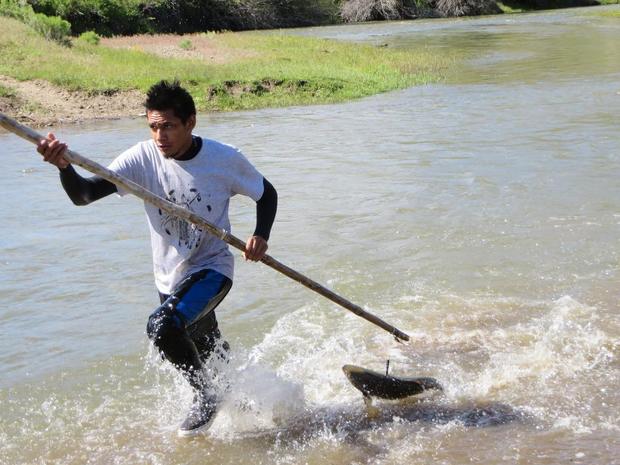forum
library
tutorial
contact

Salmon Swim in the Owyhee River After 87 Years,
and the Shoshone Paiute Relearn Traditions
by Rocky Barker
Idaho Statesman, June 7, 2015
|
the film forum library tutorial contact |

|
Salmon Swim in the Owyhee River After 87 Years,
by Rocky Barker
|
 Salmon are swimming in the Owyhee River for the first time since 1928, and Shoshone Paiute tribal fishermen are catching them in Nevada.
Salmon are swimming in the Owyhee River for the first time since 1928, and Shoshone Paiute tribal fishermen are catching them in Nevada.
The historic event, engineered in part by Buster Gibson, the vice chairman of the Shoshone Paiute Tribes Business Council, restores for now the spring chinook salmon that migrated into Nevada for centuries before dams cut them off from the Pacific. Working with the Idaho Department of Fish and Game and federal fisheries officials, the tribe placed 199 salmon collected in a trap below Hells Canyon Dam and held temporarily at the Rapid River Hatchery near Riggins.
The fish were released May 28 after the tribe held a sacred "first salmon ceremony," the last celebrated 87 years ago.
"We celebrated with ceremony, we did it with prayer, we did it with song," said Shoshone Paiute Business Council chairman Lindsey Manning. "People were lined up along the banks of the river cheering and applauding."
Several elders are old enough to have memories of salmon as a child. But three generations have lost the harvest that provides both spiritual sustenance and healthy food, which fed their ancestors for centuries.
When the 3-foot-long fish arrived, some of the elders had tears in their eyes. The day before, tribal leaders sponsored a spearing workshop to teach traditional fishing methods to members who have not had the same chance to fish salmon as other Idaho tribes, such as the Shoshone-Bannock.
Weirs were placed on a 5-mile stretch of the river south of Owyhee, Nev., on the reservation to keep the released salmon there. They are expected to remain through the end of the month, until they spawn and die. Only tribal members are allowed to fish.
"How inspiring it is to see a fishing people begin to fish again after so many years," said Will Stelle, NOAA Fisheries West Coast regional administrator. "The best part is that this is only the beginning and a harbinger of more opportunities to come."
The Shoshone Paiute live on the 289,819-acre Duck Valley Reservation 130 miles south of Boise, where many of their ancestors lived for part of the year. About 1,700 of the more than 2,000 tribal members live on the reservation, which was established by presidential order in 1877 and expanded in 1886 and 1910.
The location was picked in part because of the salmon that swam in the Owyhee River running through the reservation. Manning remembers his father's stories of anglers dropping off salmon at his house from buckboard wagons.
His father also told of salmon so large they "would hang off the saddlehorn of a horse with its tail touching the ground."
But development during the 20th century chipped away at the migration route for the great fish that came from the Pacific, up the Columbia and Snake rivers and finally up the Owyhee, a nearly 900-mile journey. The last run was 1928, before Owyhee Dam construction closed off the river. It was completed in 1932.
Then Idaho Power built Brownlee, Oxbow and Hells Canyon dams in the 1950s and 1960s. The required fish passage system failed, killing tens of thousands of salmon heading for tributaries such as the Owyhee.
Idaho Power convinced federal regulators to allow it to offset the blockage with hatcheries, which have provided fisheries throughout Idaho. But the deal ended what few salmon runs had survived into Nevada.
In 2007, then-Senate Majority Leader Harry Reid of Nevada asked federal regulators to require Idaho Power to provide passage to salmon and steelhead above its Hells Canyon complex on the Snake River as part of its new license.
Reid wrote to Joseph T. Kelliher, chairman of the Federal Energy Regulatory Commission, urging the commission to do what it can to restore salmon runs to Nevada.
"Some of our state's proud ranchers still recall a time when salmon would spawn in the streams that crisscross their meadows and fields," he wrote.
Commission officials said in 2005 that Idaho Power would not be required to include fish passage in its application for a new 50-year license for the three dams because water quality above the dams was too poor to support salmon and steelhead. But it still has not issued a license because of unresolved issues on water temperature and water quality issues.
Nevada sportsmen had joined the ShoPais, as they call themselves, in the effort to have salmon captured below Hells Canyon trucked to Nevada rivers for anglers, much like Boise River anglers have done since the 1990s. That effort languished.
But ShoPai tribal officials didn't give up. They authorized studies in 2013 that showed the East Fork of the Owyhee River and other headwaters of the Owyhee had sufficient flow and water temperature conditions to support salmon.
Armed with the data, Gibson asked Yost, one of Idaho's members on the Northwest Power and Conservation Council -- it recommends projects for the Bonneville Power Administration and other federal agencies -- to push for the tribes during consultations in 2014. Getting all the approvals necessary made it impossible to do last year.
Fish and Game was able to complete the necessary protocols this year, but there is no guarantee it will continue every year.
"We'll take it one step at a time," Yost said.
Related Pages:
Nature Notes: Nevada's Salmon Fishing, Remembered by Larry Hyslop, Elko Daily Free Press, 3/5/17
learn more on topics covered in the film
see the video
read the script
learn the songs
discussion forum
